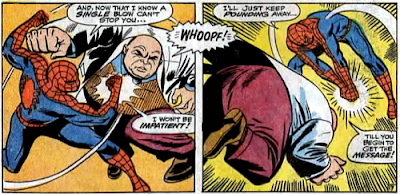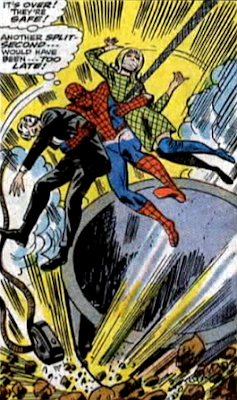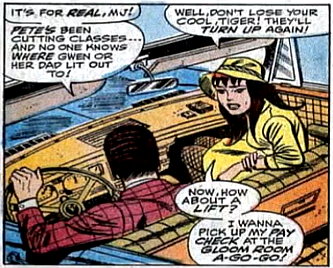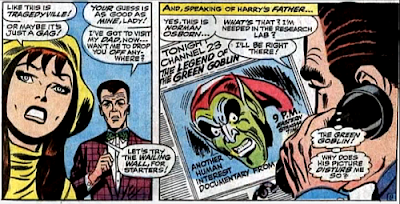(Vat's all, folks. Cover from June 1968.)
"What A Tangled Web We Weave--!"
Written by Stan Lee
Layouts by John Romita
Pencils by Don Heck
Inking by Mickey Demeo
Lettering by Sam Rosen
Mickey Demeo's back! Why this should give me such pleasure, I don't know but, in his previous run on the title, I did grow quite attached to his inking and it has to be said, it does work remarkably well with Don Heck's pencils. He's so much better than that awful Mike Esposito who's been inking the last few issues.
What's that? Mickey Demeo is Mike Esposito?
I'll get my coat. :(
The story kicks off with a symbolic splash page showing a group of Peter Parker's friends and loved ones battling to escape the sticky entanglements of his webbing. Although, bearing in mind Mary Jane's presence - and her activities on her last appearance - it could also be interpreted as them doing a very strange kind of dance. Either way, the message is clear, that being involved in the life of Peter Parker does not a happy bunny make.
One particular unhappy bunny is Gwen Stacy who, thanks to The Daily Bugle, has just discovered her dad's a thief. In time-honoured fashion, he decides to do a runner and she goes with him, declaring that wherever he goes she goes. Gwen's mother is nowhere to be seen. Were we ever told what happened to her?
The point does bring up another question, the matter of parents in Spider-Man. Peter Parker's an orphan. Harry Osborn's mother's dead. Gwen Stacy's mother appears to be dead. As she seems to have been brought up by her Aunt Anna, it seems reasonable at this time to assume that Mary Jane's parents are dead. Unless memory fails me, I'm fairly sure that John Jameson's mother's also dead. If Flash Thompson has parents, they're never referred to. In fact, throughout Stan Lee's writing of the 1960s, there seems to be a preponderance of dead or missing parents but nowhere is this felt more strongly than in the pages of Spider-Man. Is this coincidence? Was it a deliberate policy? Does it reflect on the inner psychology of Lee? Bearing in mind Batman and Superman's orphaned state, is it merely a convention of super-hero comics? Only Lee could tell us.
Back home, Peter realises what a total plonker he's been. By exposing Stacy, he's put the ex-cop's life in danger and, by leaving Gwen alone with a potentially violent brainwashing victim, he's also exposed her to terrible risk. There's only one thing for it. Unlike the police - who seem not to have thought of descending on the Stacy residence to arrest the man - Petey, in his Spider-Man guise, heads over there...
...just in time to see some of the Kingpin's goons leaving the place.
The goons have arrived too late. The Stacys are already at the airport, but they get no further as two more of the Kingpin's men apprehend them there. At first Gwen, not unreasonably, thinks they're cops but soon cottons on to the fact that they're not.
The goons take them to the Kingpin's secret lab, which it's already been revealed is in Norman Osborn's chemical plant. Osborn, who's been having troubling flashbacks to the death of the Green Goblin, has almost accidentally stumbled on the lair but has been fobbed off by Kingie's science stooge, the worryingly named Winkler. Now, Gwen and the Captain are tied together under a huge vat of lead just asking to be dropped on them. Why he doesn't just shoot them is anyone's guess but that's criminal masterminds for you.
Spidey smashes in through a window and confronts the villain. How did he know where they were? Back at the Kingpin's club he checked out the site of the now-removed brainwashing machine and found a manufacturer's tag associated with Osborn's company. The usual fight breaks out. This time our hero's shown some foresight and put a gas mask on under his spider-mask, to make sure the Kingie's trick tie-pin can't work on him.
And that's when Norman Osborn finally stumbles on the Kingpin's lair. Spotting Winkler waving a gun around, he rugby-tackles the scientist but that makes Winkler accidentally fire the gun. The bullet hits the brainwashing machine. The machine explodes. The explosion snaps a cable and that vat of molten lead, begins to fall.
And Gwen and her dad are sat right beneath it!
Spidey swings to the rescue and gets the two captives out of the way. How Osborn survives the floor being flooded with boiling lead isn't revealed. Meanwhile, Spidey goes in pursuit of the Kingpin but, too late, the corpulent king of crime has fled in Osborn's private helicopter that just happened to be sat on the roof. Finally showing some appetite for their job, the police turn up and, irony of ironies, Gwendolyne helps to give the web-slinger some good PR by telling everyone of his part in the rescue.
So, Gwen Stacy, who just a few issues back hated Spider-Man and loved Peter Parker, is now a confirmed Spider-fan and hates Peter Parker. Clearly, it's not entered her head that Peter's grapple with her father in the previous issue might have had anything to do with her dad's brainwashing. Gwen, who just months earlier was quite the spunky, feisty, lively romantic counter-foil - MJ with a brain - is rapidly becoming the character Gerry Conway was so happy to get rid of.
I have to admit that, despite all this action and drama, my favourite scene this issue is one that's technically irrelevant. In it, Mary Jane and Harry go to the club to collect her pay for her previous night's work; only to find the place shut down and abandoned.
Leaving aside how great her hat is, and that we finally get the pleasure of seeing Mary Jane being unhappy, it's the little scenes like these - that, in strict terms, aren't really necessary to the story - that give the strip its distinctive feel and make it quite unlike other super-hero titles of the time.
It's interesting too what's happening with the art. Thanks to the credits, it's a little vague as to who's doing what by now. John Romita seems to be doing the layouts, with Don Heck doing the actual pencilling but some of the faces are clearly being drawn by Romita, and, in at least one panel, the whole figure of Spider-Man seems to have been done by him. It's a strange confusion of roles and styles that, involving various other artists, would affect the strip for a surprisingly long time to come. It wouldn't be true to say the title suffered because of it but it is odd that, for a lengthy period, what had become Marvel Comics' flagship title seemed incapable of settling on a single artist.








































No comments:
Post a Comment